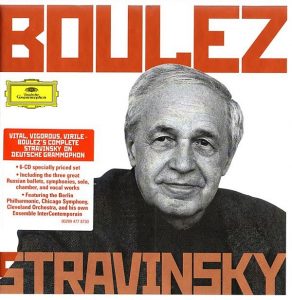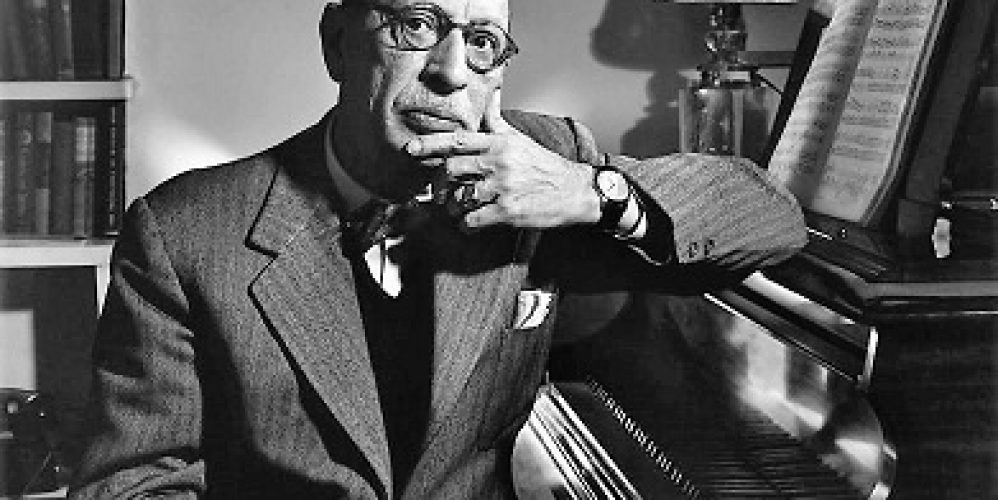The Beethoven year may have largely fallen through, the Stravinsky year will be spared that fate, but nobody will expect any live tributes to the composer who died 50 years ago. Lovers of Igor Stravinsky’s (1882 – 1971) work have to make do with online meetings, radio broadcasts and two compilation boxes that give an overview of the career of the Russian-born composer.
Warner Classics presents the Igor Stravinsky Edition (23 CDs) with musical highlights. Simon Rattle, Charles Dutoit, Natalie Dessay, Dawn Upshaw and Gidon Kremer play and conduct, besides Stravinsky’s well-known works, rarely played pieces like the ‘Piano Sonata in F-sharp’ (1903), ‘Movements for piano and orchestra’ (1959) and ‘Perséphone’ (1933). All in all, thirty hours of music of excellent quality.

Deutsche Grammophon has given previously released albums on which Pierre Boulez (1925 – 2016) conducts Stravinsky a fresh look. The enthusiasm Boulez knew how to evoke for Stravinsky’s music can still be heard on live recordings, where the audience welcomes the conductor as if he were a pop star. Boulez seems to tackle ‘The Firebird’ with an extra dose of passion.
Boulez’ empathetic approach to Stravinsky’s music is still stimulating today. Boulez had a better feel for Stravinsky’s spirited, jazz-inspired rhythms than many other conductors. He shows this, for example, in rousing performances of ‘Petrushka’ and ‘Le Sacre du Printemps’.

Stravinsky’s star only really started to shine after he met Sergey Djagilev (1872 – 1929) in Paris. In 1910, the artistic director of the Russian dance company ‘Ballets Russes’ asked the composer to write music for his ballet ‘The Firebird’. The collaboration went well and the next project would be a ballet about a pagan spring ritual. ‘Le sacre du Printemps’ premiered on 29 May 1913 at the Théâtre des Champs-Elysées in Paris. The audience reacted indignantly and vociferously to what they saw as a provocative ballet and its ‘primitive’ rhythms.
Despite, but certainly also thanks to this tumultuous start, ‘Le sacre’ became one of the best known and most praised pieces of modern music. After the outbreak of the First World War, Stravinsky spent some time in Switzerland. In the compositions from that period, he incorporated Russian poetry and folk tales.
Stravinsky was constantly renewing himself musically. As a composer, he was unique and could not be classified in any musical movement. He had little affinity with the twelve-tone music of his contemporary Arnold Schoenberg, although he ventured into it at a later age. He had more appreciation for swinging American ragtime music. Stravinsky and his European audience grew apart, but in America the interest in his music increased. In the 1930s, the composer and conductor emigrated with his family to the United States.

Stravinsky’s Russian Orthodox sympathies can be heard in ‘The Symphony of Psalms’ that he wrote on the occasion of the fiftieth anniversary of the Boston Symphony Orchestra. As he grew older, Stravinsky’s Orthodox roots became more and more important for him: ‘Religious music without religion is vulgar’, he believed.
In his later life, Stravinsky immersed himself in the work of Anton Webern (1885 – 1945) and Johann Sebastian Bach (1685 – 1750). These influences can be heard in the opera ‘The Rake’s Progress’ and the cantata ‘Canticum Sacrum’, dedicated to the city of Venice. Igor Stravinsky died on 6 April 1971 in his New York apartment. His funeral service took place in the Santi Giovanni e Paolo Basilica in Venice. The composer was buried on the island of San Michele.
Igor Stravinsky: Edition
Various artists – Warner Classics (23CD)
Boulez Conducts Stravinsky
Pierre Boulez – Deutsche Grammophon (6 CD)





